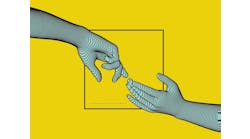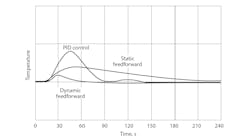Q: Your explanation of direct- vs. reverse-acting control provided much clarity about fail open (FO) and fail close (FC) valves, and the controller outputs to achieve the desired result (March 2014). Now, I'm working through several problems on override control, specifically high/low selectors, and would like you to explain these by example or recommendation for clear, concise reading material.
Christopher Perumal / [email protected]
----------
A: The various selection techniques can not only provide limits or overrides, but can also increase reliability and prevent reset windup by the use of external reset. These are large topics that Greg Shinskey explained in Chapter 2.28 of my handbook (Volume 2, 4th edition), and I will only briefly discuss them here.
Selective control is used whenever the controlled variables outnumber the manipulated ones (control valves). One application of selective control is the use of selective overrides. In these systems, the override controllers remain inactive until their constraint (setpoint) is reached or exceeded, at which point they take over the control of the valve.
A common selective override application is steam flow control with pressure override. In this case, the control valve is normally manipulated to keep the steam flow constant (FIC in Figure 1), but is switched over to pressure control if the steam pressure—to the critical user—reaches the setpoint of the PIC (soft constraint). If in spite of switching from FIC to PIC control, the pressure continues to rise and reaches the "hard constraint" on the system, alarms are actuated or shutdown is triggered.
[sidebar id =1]
Naturally, selective override control can be provided by using multiple override controllers. One example is in boilers, where we normally control the flow of combustion air on carbon monoxide control, but also provide overrides to keep opacity, stack temperature, hydrocarbons and excess oxygen within acceptable limits.
Selective override applications can also serve to guarantee valve closure. For example, when controlling the feed flow to a distillation column, a bottoms level override is provided to make sure that the feed valve is closed when the bottoms level reaches 100%.[Another selective override application is the use of startup and shutdown overrides. If a process is too complex for the operators to manually control during startup or shutdown, automatic override controls are used. Such automatic controls provide overrides to protect against violation of several constraints. An example is starting up a distillation column, where ramping signals are usually used to open valves and override controls are provided to:
- Pinch steam on low base level or on high pressure differential, which can cause flooding,
- Pinch feed valve on high base level, and
- Pinch reflux on low condenser level, and increase it on high condenser level.
Selective control can also provide smooth transition among multiple fuels. In cases where one fuel is more expensive than another, the output signal from a temperature controller, which represents the total heat input needed, is used to control the lower-cost fuel A (the high limit on the required heat input is inactive, not selected by the low signal selector that sets the flow), and therefore the valve on the higher-cost fuel B remains closed. Then, when the high heat demand limit is reached, the setpoint of the higher-cost fuel B starts to increase smoothly.
A common consequence of controller selection is that some controllers will always be blocked. So, if the output of a controller can't reach the manipulated variable (control valve) and has integral action (I, PI or PID), that action will continuously integrate (if an error exists), and will eventually saturate its output (cause it to reach its maximum limit). The consequence of this is, when control is switched back to such a controller, it will bump the process (temporarily fully open or close the valve).
To prevent that from happening, we use external feedback (EF) from the active manipulated variable or from the measurement, so the integral mode of the blocked controller will see zero error and the controller output will not saturate, but will be ready to take over control without causing a bump.
EF is required not only in selective control, but in all control systems where the controller output can be blocked. This includes cases where the operator switches the setpoint of the slave to manual. Figure 2 shows a temperature (master) setting the setpoint of a slave (flow) controller with pressure override. The master controller output can be blocked when the operator switches the system to slave control. In that case, the master needs ER from the measurement of the slave to prevent reset windup.
The slave controller (FIC in Figure 2) output can also be blocked by the pressure override, when the low signal selector (FY) selects the output of the override PIC for control. To protect from reset windup in both FIC and PIC controllers, ER has to be provided from the manipulated signal going to the valve.
[sidebar id =2]
Yet another use of selective control in critical control systems is to select the most reliable among multiple sensors or transmitters. For example, in critical reactor feed applications or in hostile environments (corrosive, dirty, vibrating, high-temperature), we often assure measurement reliability by using median selectors or voting systems to disregard a failed detector among three sensors. On other processes, such as fixed-bed chemical reactors, we can measure the temperature at several locations and select the hottest measurement for control.
Béla Lipták / [email protected]
----------
A: A common high/low override control situation occurs when trying to control two variables with only one control valve. Obviously, you can’t control both measurements at the same time to keep both setpoints constant. One has to be the main control variable and the secondary will be under constraint control.
An example of low select override occurs when controlling steam flow(s) to a reboiler from a common steam header. As the reboiler requires more steam, the valve opens up and passes more steam. There may be several pieces of equipment on the steam header, and there may be a total steam flow limitation. Under certain conditions, the steam header pressure will get too low. The constraint control would be to use a pressure controller with a setpoint lower than the normal running pressure of the header.
In this configuration, the inputs to the low selector would be the header pressure and the reboiler flow controller outputs, and the low selector output would be the lower of the two controllers. In this configuration, when the pressure is higher than the pressure setpoint, the flow controller controls the valve. If the valve draws too much steam and/or the steam generation is reduced for some reason and the header pressure drops below the pressure setpoint, the system will start cutting back the flow to the reboiler (i.e., close the valve even if the flow requirement is not met).
You would use this low selector override control configuration when the reboiler flow is less critical and it's more important to maintain the steam pressure above some minimum for the more important process users.
Similar logic is used for high selection.
Simon Lucchini / [email protected]
----------
A: I recently implemented a system with four masters to decide which has to take control. If you're interested, I can share it with you. Don't hesitate to contact me if you need more help or more explanations.
Avihu Hiram / [email protected]
Continue Reading
Latest from Multivariable Control

Leaders relevant to this article:


